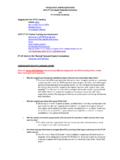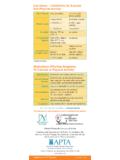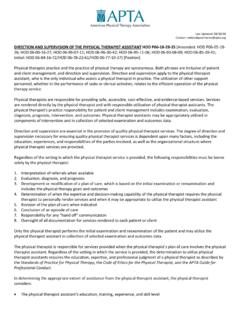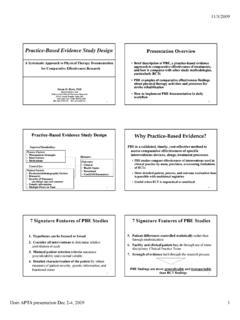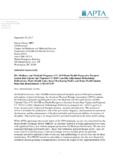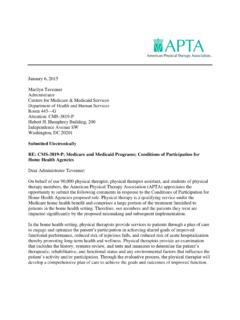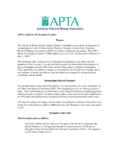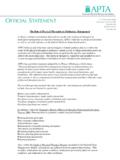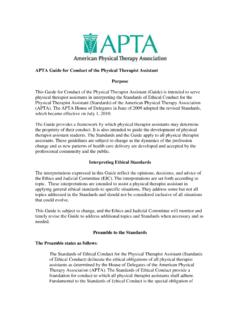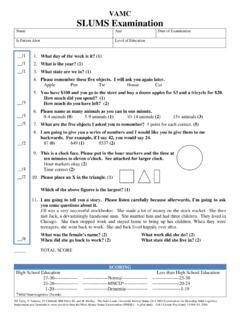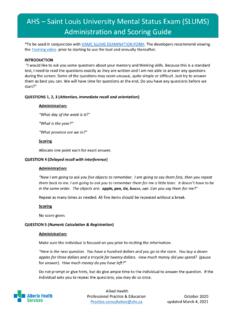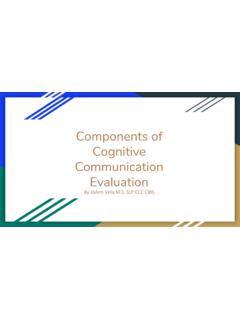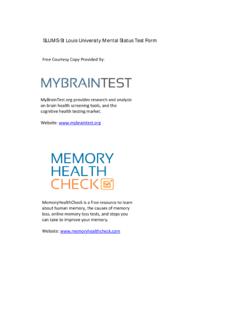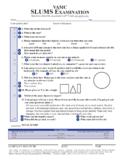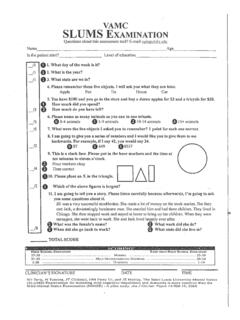Transcription of COVID-19 Core Outcome Measures - APTA
1 2020 American Physical Therapy Association. All rights reserved. APTA s academies and sections formed the Cross-Academy/Section COVID-19 Core Outcome Measure Task Force to identify a core set of Outcome Measures for patients diagnosed with COVID-19 , across the continuum of care and in all settings. A core set of Outcome Measures aids in describing the trajectory of recovery from COVID-19 and facilitates research initiatives. Core Outcome Measures A set of core Outcome Measures enables clinicians to use consistent, objective measurement strategies in developing effective plans of care and allows for the aggregation of data on the impacts of interventions related to COVID-19 on the movement system. These Measures apply across patient populations and are recommended for all patients diagnosed with or recovering from COVID-19 who have goals to improve in these five constructs. To ensure consistency and better understand trends in functional recovery, use these core Outcome Measures according to the algorithm beginning on page 3*: 1.
2 Cognition: Saint louis university mental status examination ( slums ). 2. Quality of Life: PROMIS Global 10 (clinical practice or research) EQ-5D-5L (international research). 3. Strength: Medical Research Council Sum Score (MRC-SS). 4. Function: Short Physical Performance Battery (SPPB): o Provide raw score for gait speed for comparison with other patients and across the continuum. o Provide raw score for the 5 Times Sit-to -Stand Test for comparison with other patients across the continuum. 5. Endurance: 2-Minute Step Test. Clinical Considerations General Recommendations Review the mental health, neurology, and cardiovascular and pulmonary considerations within the algorithm before beginning and while administering the tests as noted on the algorithm. Attempt all Measures if the patient can consistently follow commands, keeping in mind that not all Measures must be performed on the same visit. The tests are presented in order of expected difficulty, but use your clinical judgment to determine the optimal order of completion for each patient.
3 Communicate and collaborate with the patient s other providers when there are any concerns regarding vital signs, response to activities, or new or adversely progressive signs or symptoms. Before Performing the Core Outcome Measures Assess the patient for safety and ability to participate. Perform an individualized safety screening (see Start on the algorithm) based on the patient s severity of illness, past medical history, and current situation. COVID-19 Core Outcome Measures APTA Academies and Sections Consensus Statement American Physical Therapy Association / 2 Screen for the patient s cognitive ability to complete the core Outcome Measures . Consider these five simple commands: Close and open your eyes. Look at me. Stick out your tongue. Nod your head. Raise your eyebrows. If delirium is a concern, complete the Richmond Agitation-Sedation Scale before performing the Confusion Assessment Method. Screen cardiovascular risk status prior to exercise and endurance testing, using a weighted risk-factor calculator such as the American College of Cardiology ASCVD Risk Estimator Plus.
4 Screen for venous thromboembolism disease. Collaborate with other health professionals as applicable to the setting. While Performing the Core Outcome Measures Monitor the patient s vital signs throughout examination and intervention due to the high prevalence of cardiorespiratory complications for this patient population. For patients functioning at a lower level who are unable to earn a score on the Outcome measure, record the test as a 0 to allow for tracking of change across the continuum and to inform future collaborative research initiatives. For patients who score at the ceiling or floor of a measure, see the progression recommendations within the algorithm. Return to the core set for all subsequent Measures ; for example, when the patient s status has improved beyond the floor effect or regressed to below the ceiling effect of the Outcome measure. To capture changes in the patient s abilities, return to the core set for all reassessments. After Performing the Core Outcome Measures Complete additional tests and Measures warranted by the patient s clinical presentation.
5 If any Outcome measure cannot be completed, score the test as a 0 and indicate the reason it was not possible to complete, such as the patient declined to participate, or the patient s delirium prevented participation. This will enable better documentation of change later in the continuum of care. For guidance with patients who present with balance deficits, see the neurology considerations within the algorithm. Even if in your practice setting you might not report or track changes with each of the proposed outcomes Measures , each score remains significant. The score a patient receives at your setting should be shared across the continuum of illness to serve as a baseline or intermediate time point for measuring change in later settings. *The Task Force is developing recommendations for secondary Outcome Measures to provide a more full understanding of impairments, including recommendations for tests and Measures for individuals across the lifespan; those with lower functional levels, such as patients still in the ICU; and those with higher functional levels, such as athletes returning to sport.
6 The Task Force also is developing a recommendation to screen for additional impairments such as delirium, depression, anxiety, and upper extremity dysfunction. START: Complete thorough chart review (including labs and imaging) and systems review. When available, place emphasis on: Wells Clinical Prediction Rule for venothrombus embolism and screen for cardiovascular disease, heart failure, and : Communicate with health care vitals throughout. Signs or symptoms of an unexpected response to activity should impact clinical decision making and require communication with the health care team. Refer to cardiovascular and pulmonary considerations. Complete quick cognitive screen ( , alert and oriented, RASS, complete five commands).Perform CAM for caregiver to assist with PROMIS or EQ-5D-5L. Begin core Measures (always include raw data and sum scores).Perform slums * (see Frequency Recommendations below).Perform PROMIS or EQ-5D-5L with caregiver assistance as needed and provide component PROMIS or EQ-5D-5L and provide component MRC SPPB (with raw score for all components).
7 Perform 2-Minute Step appropriate tests and Measures for varying presentations. Refer to mental health, pediatric, neurology, and cardiovascular and pulmonary : Communicate with health care performing either the Disabilities of the Arm Shoulder and Hand or SPPB as 0 then com-plete Function in Sitting 2 MST as 0 and consider Seated Step Test (see Cardiac Endurance Tests) or Arm Ergometry Test (requires equipment).Score SPPB as 12 and consider other validated work-, capacity-, or sport-specific tests based on patient s role and responsibilities. Score the 2 MST and consider another validated graded exercise test that allows estimation of VO2peak or MET level. Consider other validated strength or power tests and Measures when ei-ther upper or lower extremity MRC-SS reaches 30 appropriate tests and Measures for varying presentations. Refer to mental health, pediatric, neurology, and cardiovascular and pulmonary considerations. APTA 2020. All rights Core Outcome Measures : Clinical Application AlgorithmYesYesNoNoAre vitals stable?
8 Able to understand directions?Score of <20 Score of 20If upper extremity deficitsIf at floor effectIf at floor effectIf at ceiling effectIf at ceiling effectIf at ceiling effectKEY: *Link to developer website, and use search feature to find measure. Multiple measure descriptions are available; select the most appropriate for your Recommendations: Perform all tests on entry to PT services. Repeat prior to discharge or discontinuation, entry to next setting, and any time there is a significant change. Disease interval testing frequency: 30 days and 3, 6, and 12 months post COVID-19 : Complete if no prior score has been attained, at 1-2 months following hospital discharge, with a suspected drop below baseline in a postacute setting, or at discharge from all PT services when a prior deficit was noted and the patient is not receiving skilled speech-language-pathology CONSIDERATIONSC ardiovascular and Pulmonary: Refer to the American College of Sports Medicine for screening and exercise testing guidelines.
9 Follow individualized vital sign parameter orders from the provider. Throughout the evaluation, record a dyspnea scale score and rate of perceived exertion. Complete the 6-Minute Walk Test when the patient is able to complete the gait speed portion of the SPPB (as space allows). Consider the Ankle Brachial Index. mental health: Consider the impact of social isolation, emotional state, functional ability loss, critical care survivorship, and changes in work or life situations on the patient s mental health, and screen and refer appropriately. Consider the Hospital Anxiety and Depression Screen and screening for posttraumatic stress disorder. Pediatric Population: Patients under 18 years of age require special consid-erations, which will be addressed in a separate algorithm under development. Neurology: Consider the impact of impaired sensory systems and coordination. If there are dual-task deficits, consider the Timed Up and Go Cognitive Test. For upper extremity neurological deficits, consider the Finger Tapping Test and the Goal Attainment Scale.
10 For lower extremity neurological or balance deficits, consider the Neuro Core Outcomes Set. If presentation is similar to stroke, refer to StrokeEDGE. American Physical Therapy Association / 4 Process The Cross-Academy/Section COVID-19 Core Outcome Measure Task Force was organized in April 2020 and comprises members appointed by the following APTA academies and sections: the Academy of Acute Care Physical Therapy, the Cardiovascular and Pulmonary Section, APTA Geriatrics, the Home Health Section, the Academy of Neurologic Physical Therapy, the Academy of Oncologic Physical Therapy, the Academy of Orthopaedic Physical Therapy, and the Private Practice Section. Members include clinicians, academicians, and scientists who provide perspectives across the continuum of patient care and from varied clinical specialty areas. We used available information from the United States and other countries to determine the most common impairments related to COVID-19 , and then identified constructs cognition, endurance, function, quality of life, and strength that best reflect these impairments.
